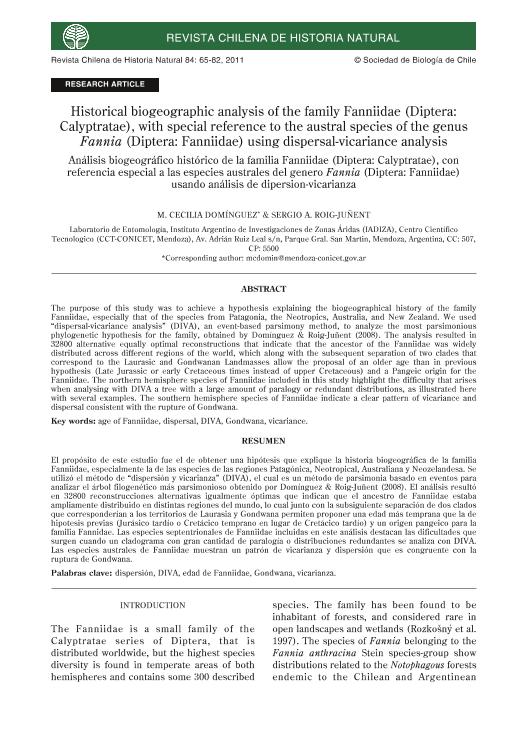Mostrar el registro sencillo del ítem
dc.contributor.author
Dominguez, Martha Cecilia

dc.contributor.author
Roig, Sergio Alberto

dc.date.available
2019-04-15T14:50:42Z
dc.date.issued
2011-03
dc.identifier.citation
Dominguez, Martha Cecilia; Roig, Sergio Alberto; Historical biogeographic analysis of the family Fanniidae (Diptera: Calyptratae), with special reference to the austral species of the genus Fannia (Diptera: Fanniidae) using dispersal-vicariance analysis; Sociedad de Biología de Chile; Revista Chilena de Historia Natural; 84; 1; 3-2011; 65-82
dc.identifier.issn
0716-078X
dc.identifier.uri
http://hdl.handle.net/11336/74369
dc.description.abstract
El propósito de este estudio fue el de obtener una hipótesis que explique la historia biogeográfica de la familia Fanniidae, especialmente la de las especies de las regiones Patagónica, Neotropical, Australiana y Neozelandesa. Se utilizó el método de "dispersión y vicarianza" (DIVA), el cual es un método de parsimonia basado en eventos para analizar el árbol filogenético más parsimonioso obtenido por Domínguez & Roig-Juñent (2008). El análisis resultó en 32800 reconstrucciones alternativas igualmente óptimas que indican que el ancestro de Fanniidae estaba ampliamente distribuido en distintas regiones del mundo, lo cual junto con la subsiguiente separación de dos clados que corresponderían a los territorios de Laurasia y Gondwana permiten proponer una edad más temprana que la de hipotesis previas (Jurásico tardío o Cretácico temprano en lugar de Cretácico tardío) y un origen pangeico para la familia Fannidae. Las especies septentrionales de Fanniidae incluidas en este análisis destacan las dificultades que surgen cuando un cladograma con gran cantidad de paralogía o distribuciones redundantes se analiza con DIVA. Las especies australes de Fanniidae muestran un patrón de vicarianza y dispersión que es congruente con la ruptura de Gondwana.
dc.description.abstract
The purpose of this study was to achieve a hypothesis explaining the biogeographical history of the family Fanniidae, especially that of the species from Patagonia, the Neotropics, Australia, and New Zealand. We used "dispersal-vicariance analysis" (DIVA), an event-based parsimony method, to analyze the most parsimonious phylogenetic hypothesis for the family, obtained by Domínguez & Roig-Juñent (2008). The analysis resulted in 32800 alternative equally optimal reconstructions that indicate that the ancestor of the Fanniidae was widely distributed across different regions of the world, which along with the subsequent separation of two clades that correspond to the Laurasic and Gondwanan Landmasses allow the proposal of an older age than in previous hypothesis (Late Jurassic or early Cretaceous times instead of upper Cretaceous) and a Pangeic origin for the Fanniidae. The northern hemisphere species of Fanniidae included in this study highlight the difficulty that arises when analysing with DIVA a tree with a large amount of paralogy or redundant distributions, as illustrated here with several examples. The southern hemisphere species of Fanniidae indicate a clear pattern of vicariance and dispersal consistent with the rupture of Gondwana.
dc.format
application/pdf
dc.language.iso
eng
dc.publisher
Sociedad de Biología de Chile

dc.rights
info:eu-repo/semantics/openAccess
dc.rights.uri
https://creativecommons.org/licenses/by-nc-sa/2.5/ar/
dc.subject
AGE OF FANNIIDAE
dc.subject
DISPERSAL
dc.subject
DIVA
dc.subject
GONDWANA
dc.subject
VICARIANCE
dc.subject.classification
Otras Ciencias Biológicas

dc.subject.classification
Ciencias Biológicas

dc.subject.classification
CIENCIAS NATURALES Y EXACTAS

dc.title
Historical biogeographic analysis of the family Fanniidae (Diptera: Calyptratae), with special reference to the austral species of the genus Fannia (Diptera: Fanniidae) using dispersal-vicariance analysis
dc.title
Análisis biogeográfico histórico de la familia Fanniidae (Diptera: Calyptratae), con
referencia especial a las especies australes del genero Fannia (Diptera: Fanniidae)
usando análisis de dipersion-vicarianza
dc.type
info:eu-repo/semantics/article
dc.type
info:ar-repo/semantics/artículo
dc.type
info:eu-repo/semantics/publishedVersion
dc.date.updated
2019-04-03T14:55:34Z
dc.identifier.eissn
0717-6317
dc.journal.volume
84
dc.journal.number
1
dc.journal.pagination
65-82
dc.journal.pais
Chile

dc.journal.ciudad
Santiago de Chile
dc.description.fil
Fil: Dominguez, Martha Cecilia. Consejo Nacional de Investigaciones Científicas y Técnicas. Centro Científico Tecnológico Conicet - Mendoza. Instituto Argentino de Investigaciones de las Zonas Áridas. Provincia de Mendoza. Instituto Argentino de Investigaciones de las Zonas Áridas. Universidad Nacional de Cuyo. Instituto Argentino de Investigaciones de las Zonas Áridas; Argentina
dc.description.fil
Fil: Roig, Sergio Alberto. Consejo Nacional de Investigaciones Científicas y Técnicas. Centro Científico Tecnológico Conicet - Mendoza. Instituto Argentino de Investigaciones de las Zonas Áridas. Provincia de Mendoza. Instituto Argentino de Investigaciones de las Zonas Áridas. Universidad Nacional de Cuyo. Instituto Argentino de Investigaciones de las Zonas Áridas; Argentina
dc.journal.title
Revista Chilena de Historia Natural

dc.relation.alternativeid
info:eu-repo/semantics/altIdentifier/url/http://rchn.biologiachile.cl/pdfs/2011/1/Dominguez_and_Roig-Junent_2011.pdf
dc.relation.alternativeid
info:eu-repo/semantics/altIdentifier/url/https://scielo.conicyt.cl/scielo.php?script=sci_arttext&pid=S0716-078X2011000100005
dc.relation.alternativeid
info:eu-repo/semantics/altIdentifier/doi/http://dx.doi.org/10.4067/S0716-078X2011000100005
Archivos asociados
